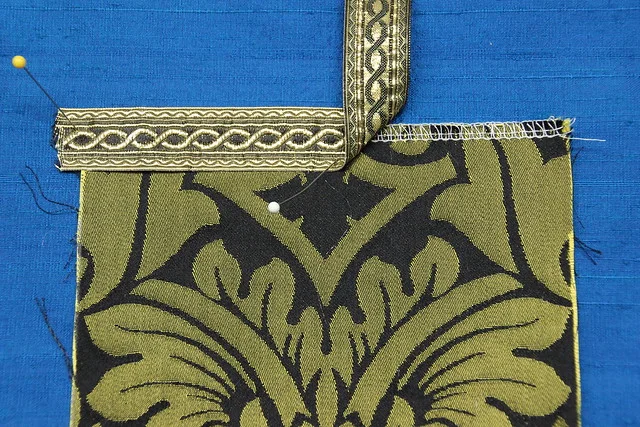Sewing Galloon Trim to Orphrey Bands
Sewing Galloon Trim to Orphrey Bands: Tonight we will take a short look at applying gallon trim to the Orphrey bands. The orphrey bands are being placed on a pastoral stole. We have been looking at stoles for a while, but there is so much ground to cover when it comes to making a stole. Many of these tips and techniques can help give a stole that polished professional look when completed. But no need to worry. Making stoles is a process, as are all Ecclesiastical Sewing Projects. It takes time, patience, a bit of looking back and reflecting, and practice to progress in stole-making skills.
So for today, let’s look at a little tip that will help your stoles not only look nice and more professional, but it may also save a bit of time in the construction process as well.
Applying Ecclesiastical Braid to Orphrey Bands
If you flip through the pages of some of the Ecclesiastical Vestment catalogs, you may notice pre-made orphrey bands that already have the galloon braid applied to the base fabric. These pre-made orphrey trims can get rather pricey in a big hurry. But let’s follow the construction approach of these pre-made bands and pre-make orphrey bands before applying them to the stole fabric.
In a previous post on Orphrey bands, we were using the Black/Gold Fairford fabric with the St. Benet Galloon in Black/gold. The balloon is positioned about halfway along the edge of the fabric and pinned in place.
The fabric and trim are ready for stitching once everything is lined up. The trick is to position the galloon so that the surged edge of the fabric is at least halfway up on the trim. If one places it too far up, it may stick out on the upper edge. If it is not positioned far enough, the risk of having the fabric fray increases.
This is Gold St. Benet with the Ivory/Gold St. Hubert Galloon. You may notice that the sewing machine is set up with an even feed foot. I like to use this when sewing Church Vestments so that both layers of fabrics feed evenly through the machine to avoid any puckering that may result from the fabrics not feeding evenly.
The needle is placed close to the edge of the galloon, and started in about 1/4″ from the edge. I back-stitch to the edge, and then stitch to the opposite end, where I back-stitch again 1/4″ and remove the fabric. The process is continued on the opposite edge of the orphrey.
Properly Stitching Orphrey Bands and Galloon Trim
Once you sew three pieces of galloon in place, measure and check the position and placement of the fourth piece of galloon to ensure it is even with the trims on the completed band. Missing this step can result in a glaring eyesore that may detract from an otherwise lovely project.
If a longer length of orphrey band is being created, follow the same steps. But, also be sure to keep your stitching perfectly straight. You may also consider the option of basting the gallon to the orphrey before stitching by machine. Some people like to use a light spray adhesive ( not my personal favorite, but I do use this method).
So why stitch orphrey bands in this order? One could certainly stitch the orphrey fabric in place, and then go back and add the gallon. I have done this myself. And, the project looked fantastic while it was on my sewing table. But that feeling of the project looking fantastic only lasted until the items were hung in the church. When I looked at the finished project, I was mortified. Oh, yes, everyone at church sang its praises, but I knew that all was not well. The end result of using 6 rows of stitches to apply orphrey bands and galloon trim was those puckers.
Take note
When creating and applying similar types of orphrey bands today, pre-making some of the work before applying it to the base fabric, and using a walking or even feed foot, prevents the puckers from showing. Here is to wishing you all, pucker-free orphrey bands.
Solo Dei Gloria
Be sure to visit our online store front Ecclesiastical Sewing where you may shop for Liturgical Fabrics, altar linen fabrics, church vestment-making patterns, liturgical machine embroidery designs, church vestment trims and notions and so much more. You may also find us on Ecclesiastical Sewing on Facebook, Twitter, and Pinterest. Sign up for our mailing list at the bottom of the page on our online store front and receive a free copy of our Small Linens Booklet as our way of saying thank you for following along.
Ecclesiastical Braids and Galloons: Finding the Right Trim
Orphrey Bands for Pastoral Stoles
Creating Orphrey Bands for Church Vestments
Black Evesham Church Vestment Fabric Orphrey
Orphrey Bands for Altar Frontal

